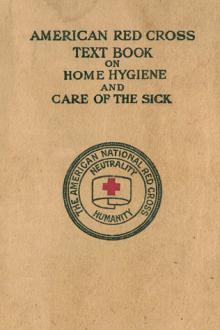American Red Cross Text-Book on Home Hygiene and Care of the Sick by Isabel McIsaac (best affordable ebook reader txt) 📕

- Author: Isabel McIsaac
- Performer: -
Book online «American Red Cross Text-Book on Home Hygiene and Care of the Sick by Isabel McIsaac (best affordable ebook reader txt) 📕». Author Isabel McIsaac
Children, 281. Physical defects, 283. Eye-strain, 284. Enlarged tonsils and adenoids, 284. Defective hearing, 285. Defective teeth, 286. Posture, 286. Predisposition to nervousness, 292. Convalescent patients, 294. Chronic patients, 299. Care of the aged, 303.
280 CHAPTER XV Questions for Review 312 AppendixCirculars of information issued by Division of Child Hygiene, New York Department of Health.
319 Glossary 326 Index 331 INTRODUCTIONHealth and sickness, at all times momentous factors in the welfare of our nation, now as never before are matters of vital importance. To win its victories both in peace and in war, the nation needs all its citizens with all their powers, and it is a matter of more than passing interest that, as conservative estimates show, at least three persons out of every hundred living in the United States are constantly incapacitated by serious sickness. In 1910 these seriously sick persons numbered more than 3,000,000. Even more significant, perhaps, is the fact that at least half of our national sickness could be prevented if knowledge and resources that we now possess were fully utilized.
The problem of sickness is by no means peculiar to our own day and generation. It has been a medical, a religious, and a social problem in every age. From the time of Job its meaning has baffled philosophers; from his day to ours thoughtful men have devoted their lives to searching for causes and cures. Yet before the middle of the last century little progress was made, either in scientific treatment or in prevention of disease.
The invention of the microscope first made possible a real understanding of sickness. Through the microscope a new world was revealed,—a world of the infinitely small, swarming with tiny forms of animal and vegetable life. No one, however, appreciated the significance of these hitherto invisible plants and animals until the latter part of the 19th century, when the great French savant, Pasteur, proved that little vegetable forms, now called bacteria, cause putrefaction and fermentation, and also certain diseases of animals and man. Pasteur's discoveries were carried still further by other scientists, with the result that bacteriology has revolutionized medicine, agriculture, and many industries, and has made possible the brilliant achievements of modern sanitary science. For the first time in history the prevention of epidemics has become possible, and sickness is no longer regarded as a punishment for sin.
Actual care of the sick, both in homes and in hospitals, has always been one of the responsibilities of women. The first general public hospital was built in Rome in the 4th century after Christ by Fabiola, a patrician lady. There she nursed the sick with her own hands, and from her day to ours extends an unbroken line of devoted women, handing down through the centuries their tradition of compassionate nursing service. It remained for Florence Nightingale, however, to give to the training its technical and scientific foundation, and thus to found the profession of nursing. As a result of her work, effectiveness was added to the spirit of service, that spirit which inspires the modern nurse no less than in an earlier day it inspired the Sisters of Charity who died nursing the wounded on the battlefields of Poland.
But different generations have different needs, and to meet them the spirit of service must manifest itself in widely varying ways. The sick need care today no less than they did when St. Elizabeth bathed the feet of the lepers; but such limited service, however beautiful, is no longer enough. Today we serve best by preventing sickness. Cure of sickness and alleviation of suffering must never be neglected; not in cure, however, but in prevention lies the hope of modern sanitary science, of modern medicine, and of modern nursing.
Nearly every woman at some time in her life is called upon to assist in caring for the sick. Indeed, approximately 90% of all sick persons in the United States are cared for at home, even in cities where hospital facilities are good. Moreover, every woman is largely responsible for maintaining her own health, and few escape responsibility at some time for maintaining the health of others. For such responsibility most women are poorly prepared. Every year in our own country thousands of persons, many of them babies and children, die merely because someone, in many cases a woman, is fatally ignorant of the laws governing sickness and health.
Only prolonged and careful training, such as good hospital training-schools afford, can furnish the skill and judgment required in nursing persons who are seriously ill. Upon the trained nurse the modern practice of medicine makes great and ever-increasing demands: a nurse must perform complicated duties, meet critical situations, and carry out a wide variety of measures based on scientific principles which she must understand. Good will and sympathy are no longer enough; amateur nursing, even when performed with the best intentions, may involve grave dangers for those who are seriously ill.
On the other hand, although it is true that a little knowledge is a dangerous thing, it is no less true that total ignorance may be more dangerous still. For instance, in cases of incipient, slight, or chronic illness, and in certain emergencies a little knowledge may be safer far than no knowledge at all; and no one, surely, should be ignorant of the principles of hygiene.
The American Red Cross, recognizing the part that women can and should play in preventing sickness and in building up the health and vigor of the nation, has added to its larger patriotic services this elementary course of instruction in hygiene and home care of the sick. The lessons are not intended to take the place of a nurse's training, and procedures requiring technical skill are necessarily omitted. The object of the book is to supply a little knowledge of sickness, which though limited may yet be safe. The book is also designed to set forth some general laws of health; to make possible earlier recognition of symptoms; to teach greater care in guarding against communicable disease; and to describe some elementary methods of caring for the sick, which, however simple, are essential to comfort, and sometimes indeed to ultimate recovery.
FOR FURTHER READING A History of Nursing—Dock and Nutting, Volume I. The Life of Florence Nightingale—Cook. The Life of Pasteur—Vallery-Radot. The House on Henry Street—Wald. Public Health Nursing—Gardner, Part I, Chapters I-III. Origin and Growth of the Healing Art—Berdoe. Medical History from the Earliest Times—Withington. Under the Red Cross Flag—Boardman. Report on National Vitality—Fisher, (Bulletin 30 of the Committee of One Hundred on National Health. Government Printing Office, Washington). CHAPTER ICAUSES AND PREVENTION OF SICKNESS
Diseases of two kinds have long been recognized: first, those transmitted directly or indirectly from person to person, like smallpox, measles, and typhoid fever; and second, diseases like heart disease and apoplexy, which are not so transmitted. These two classes are popularly called "catching" and "not catching;" the former are the infectious or communicable diseases, and the latter the non-infectious or non-communicable. The term contagious, formerly applied to diseases supposed to be spread only by direct contact, is no longer an accurate or useful term.
THE COMMUNICABLE DISEASESThe invention of the microscope, as we have seen, revealed the existence of innumerable little plants and animals, so small that even many millions crowded together are invisible to the naked eye. These tiny living creatures are called micro-organisms or germs. The plant forms are called bacteria (singular, bacterium), and the animal forms protozoa (singular, protozoön). The common belief that all or even most bacteria are harmful is quite unfounded. As a matter of fact, while not less than 1500 different kinds of micro-organisms or germs are known, only about 75 varieties are known to produce disease.
Most bacteria belong to the class of micro-organisms called saprophytes, which find their food in dead organic matter, both animal and vegetable, and cannot flourish in living tissues. These saprophytes act upon the tissues of dead animals and vegetables, and resolve them into simpler substances, which are then ready to serve as nourishment for plants higher in the vegetable kingdom. Thus the processes which we know as fermentation and putrefaction are due to the action of saprophytes. Higher plants in turn furnish food for men and animals, and so the food supply is used over and over in different forms, making what is known as the food cycle. If it were not for bacterial activities vegetation would be robbed of its supply of nourishment, and plant life would speedily end; destruction of plant life would deprive the animal kingdom of food and thus all life would become extinct. The saprophytes are consequently essential to the existence of both animals and vegetables.
There are, however, other organisms called parasites, which can exist in living tissues of animals or vegetables. The organisms at whose expense the parasites live are called their hosts. Parasites not only contribute nothing to their hosts, but generally harm them by producing poisonous substances or depriving them of food. Some parasites are able to lead a saprophytic existence also, but as a rule they live at the expense of animal or plant life. Pathogenic, or disease-producing, germs belong to the group of parasites. The pathogenic germs which find favorable soil in the body produce poisons called toxins. These poisons or toxins interfere with the bodily functions, and thus cause what we know as communicable disease. Communicable diseases are caused by specific germs only: that is, a certain disease cannot develop unless its particular germs are present; the germs of typhoid for instance, can cause typhoid fever only, and not tuberculosis or other disease.
A number of diseases are caused by micro-organisms that are now well known. Chief among these diseases are colds, septicæmia (blood poisoning), influenza, pneumonia, diphtheria, typhoid fever, tuberculosis, whooping cough, Asiatic cholera, bubonic plague, meningitis, tetanus ("lock jaw"), leprosy, gonorrhœa, syphilis, relapsing fever, typhus fever, glanders, and anthrax. Micro-organisms not yet identified probably cause the communicable diseases whose origin is not known with certainty. These include infantile paralysis, smallpox, scarlet fever, measles, mumps, chicken-pox, Rocky Mountain spotted fever, yellow fever, hydrophobia (rabies), foot-and-mouth disease. We can hardly doubt that the intensive laboratory research now in progress will reveal in the near future the specific germs of these diseases also.
STRUCTURE AND DEVELOPMENT OF PARASITESThe group of parasites consists of two general classes, the vegetable, and the animal. In the former class belong the bacteria, and in the latter the protozoa. The two classes are not





Comments (0)